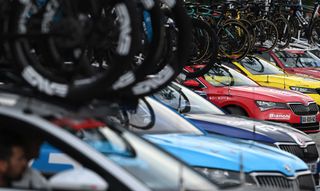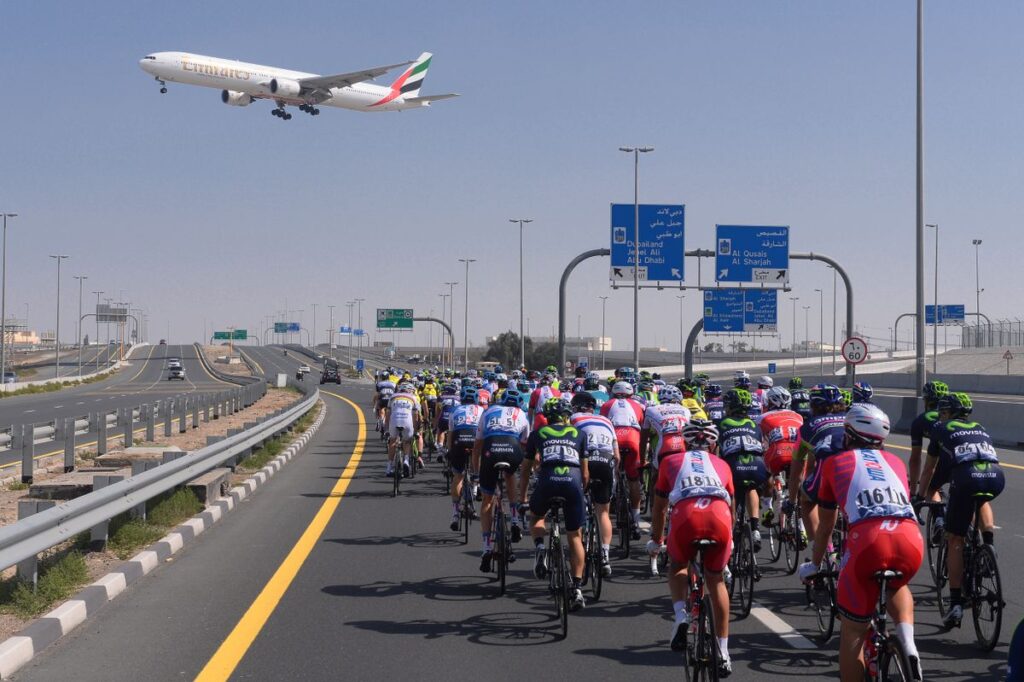The men’s and women’s WorldTour calendars take cycling to the global stage, spanning multiple continents with single-day races, stage races, and multi-week Grand Tours. However, behind the scenes, there are great logistical challenges and often exorbitant environmental costs.
For 2025, the men’s calendar features 36 races across 13 countries and four continents, and for the women, it’s 29 events across 12 countries and three continents.
The Grand Tours are the pinnacle of these calendars – the Tour de France, Giro d’Italia and La Vuelta a España for the men, and La Vuelta Feminina, Giro d’Italia Women and Tour de France Femmes for the women – and flights are regularly baked into routes. While the women’s Grand Tours have not yet necessitated long transfers, it’s another story for the men.
Regardless, all teams are required to take long-haul flights to participate in the UCI WorldTour calendar, and this has a remarkable environmental impact.
Sign up to the Musette – our subscriber-only newsletter
Compulsory emissions
The first race is the Tour Down Under which takes place in Adelaide, Australia in January as set out by the UCI.
For one rider who lives in the cycling mecca of Girona, a roundtrip flight to Adelaide emits 4.87 tons of carbon dioxide equivalents (tCO2). All emissions calculations are done as per UK government calculations for an economy class passenger.
With each team having seven riders at the Tour Down Under, we can assume approximately 613.62 tCO2 for riders. Even if we exclude the 25 Australian riders in the men’s pro peloton, on the off chance they might have an extended stay after Christmas, it’s still a remarkable environmental footprint.
50 trees on average capture 1 tCO2, therefore you need to plant over 30,000 trees to mitigate just the rider’s impact. Add in the hundreds of staff, family, friends, and spectators from abroad, and that’s a lot of trees.
As the UCI obliges the men’s teams to participate, these emissions are effectively mandatory. The same can be said for the women, who, while only ‘invited’ to the Tour Down Under, still need to participate to get points.
“The way the calendar is and the requirement to do races around the world to get points means a rider has to take every opportunity, regardless of the environmental impact,” said Victoria Hatch, carbon and sustainability consultant.
“It’s tricky, especially when you are trying to grow the women’s sport. You can’t not race because you don’t want to fly across the world, so you have to lose your environmental values.”
Grand Tour, grand impact
The 2025 Tour de France is set to feature over 3,000km of transfers, almost the same distance as riding the Tour itself at 3,320km. The longest is from Pontarlier to Mantes La Ville for the final stage in Paris. At 514km, riders are likely to fly from Geneva to Paris Charles de Gaulle or Orly rather than take several trains.
This flight would emit approximately 0.062 tCO2 per rider, thus over 10 tCO2 for all the riders, excluding rides to and from the airport, and the rest of the staff. This is the same amount as the average annual CO2 emissions per person in the UK.
ASO, who owns the Tour, first assessed the event’s carbon footprint in 2013 and says it has since seen a 37% decrease in direct emissions. For 2030, ASO aims to reduce emissions by 50% compared to 2013 and by 2040 the Tour will be carbon neutral. As part of the organisation’s environmental initiatives and to reach these goals, 100% of the Tour’s direct emissions were offset this year. However, offsetting is controversial.
Carbon offset schemes enable organisations like ASO to invest in projects that reduce, avoid, or remove carbon emissions from elsewhere in the world in order to balance out their own carbon footprint.
“Carbon offsets should be the last resource, only used to compensate for the unavoidable emissions,” said Simon Scholes, director at sustainability and circular economy consultancy, Oakdene Hollins.
“Carbon offsets border [on] greenwashing if the means to reduce the carbon footprint have yet to be exhausted. Offsets distract the organisers and the public from what really matters, which is avoiding impact.”
Showcasing Spain
The Vuelta has also been criticised for requiring extensive transfers. In 2022, the race started in the Netherlands, which meant riders flew from stage 3 in Breda to the start of stage 4 in Vitoria-Gasteiz in Northern Spain.
In this year’s edition, stage 9 finished in Granada with a rest day transfer to northern Spain in Ponteareas, nearly 1,000km away. For 176 riders to fly from Granada to the nearest airport Vigo, this emits 18.48 tCO2, and that’s without counting the fleet of buses, support vehicles, and caravans which travelled the distance by road overnight.
“Spain is one of the largest countries in Europe, with regions that vary greatly in terrain, climate, and culture,” said Pablo Osorio of La Vuelta.
“As organisers, one of our core objectives is to ensure that La Vuelta truly represents the whole of Spain, from the mountainous north to the southern coasts. This sometimes necessitates longer transfers to reach different regions, allowing us to showcase the full breadth of what Spain has to offer and bring the race closer to more communities, spreading the excitement of La Vuelta across the country.
“Having that in mind, we try to balance different factors: sport, logistics and accessibility, showcasing Spain, economic impact for host regions and environmental impact. Now we’re analysing the carbon footprint of 2024’s edition to improve the environmental impact in 2025.”
The 2025 Vuelta route starts in Turin, Italy with the finish not yet revealed but given the Italian start, it is likely there will be a flight transfer in the route, and it’s not exactly showcasing Spain by starting in a different country altogether.
In the 2024 edition of La Vuelta Feminina, the longest transfer was 223km from Jaca to Tarazona for Stage 6. Details for 2025 have not yet been revealed.

Italian indifference
It’s a similar story at the Giro d’Italia, run by RCS Sport. The organiser was forced to defend a 750km transfer to Rome in 2023 amid concerns over the environmental impact, with race director Mauro Vegni dismissing the issue of flying as “a sterile polemic”.
In 2023, teams had to transfer from Monte Lussario in the North of Italy to Rome, resulting in a 458km flight, which equated to 12.14tCO2 for the riders, and a similar story followed for this year’s edition with a 560km transfer from Bassano del Grappa to Rome for the final stage.
Notably, the 2025 Giro’s route presentation has been postponed to January but a Grande Partenza in Albania is now confirmed. This means teams will fly to the start in Albania and then fly again to Italy wherever the route continues unless organisers force teams to take the 10-hour ferry to either Brindisi or Bari in Italy. Somewhat unlikely.
RCS Sport did not comment on the matter.
Going electric
While the flight emissions rack up, the on-the-ground impact has been reduced thanks to the emergence of electric and hybrid vehicles. Both the Tour and La Vuelta use exclusively hybrid or electric light vehicles, while the Tour’s heavy-duty vehicles run on biofuel.
“Škoda provides 90 cars for La Vuelta and emphasises electromobility with a mix of full electric and plug-in hybrid vehicles,” said Osorio of La Vuelta. “Partnering with Europcar, we also have a large number of electric and plug-in hybrid cars.
“We do not use diesel generators for recharging these vehicles, instead, we employ electric vans equipped with large batteries—essentially big power banks—to recharge our electric vehicles.”
However, it is not yet the same story for the vehicles used by the teams, media, and other sections of the races’ caravan.

What advice do organisers give teams?
Navigating the logistical challenges of the WorldTour calendar is no mean feat. During Grand Tours, teams must haul riders, staff, and bikes, on the road continuously for weeks whilst ensuring everyone can function efficiently and perform at the highest level.
Grand Tour organisers say they work closely with teams to help them optimise their logistics sustainably.
“Some key recommendations we provide include planning their travel schedules to reduce unnecessary mileage or transitioning support vehicles within teams to hybrid or electric models,” said Osorio.
“Regarding the teams, an annual workshop introduces the Tour’s CSR strategy, encouraging participants to share best practices for collective improvement,” said Thomas Cariou, corporate social responsibility director at ASO.
“These discussions focus on reducing water consumption, raising awareness about sustainable travel, and promoting biodiversity preservation. For instance, the Tour has offered a free draining disposal service near team buses at departure/arrival sites for several years, allowing teams to handle logistical needs in an environmentally friendly way. We firmly believe that fostering dialogue with teams and partners is essential for adopting best practices and advancing sustainability across the cycling community.”
Restructuring the calendar
The UCI is conscious of embedding sustainability into cycling. Last year in a conversation with Cycling Weekly, UCI president David Lappartient said that WorldTour teams would need to reduce their emissions by 50 percent in 2027 compared to 2019 or risk losing their WorldTour license.
The UCI Sustainability Report details actions over the coming years which include carbon reduction targets and climate action plans for teams, and a sustainability ranking system for teams and events.
Notably, the UCI wants to ‘balance the calendar to support efforts to reduce carbon emissions from transport’, quantified by a 30% reduction of professional cycling transport emissions in 2026.
Inroads have been made this year with a working group established to look at decarbonising the calendar, but restructuring the calendar is likely to be a complex and drawn-out process, given the breadth of considerations – tradition, commercial, financial, and performance to name a few.
Plus, even if the calendar is restructured, and flights are not baked into Grand Tour routes, fans will still travel from all over the world to see the best cyclists in action. Given that ASO says 94% of the Tour’s carbon footprint is from fan’s travels, there’s a much bigger conversation to be had.
If you subscribe to Cyclingnews, you should sign up for our new subscriber-only newsletter. From exclusive interviews and tech galleries to race analysis and in-depth features, the Musette means you’ll never miss out on member-exclusive content. Sign up now

